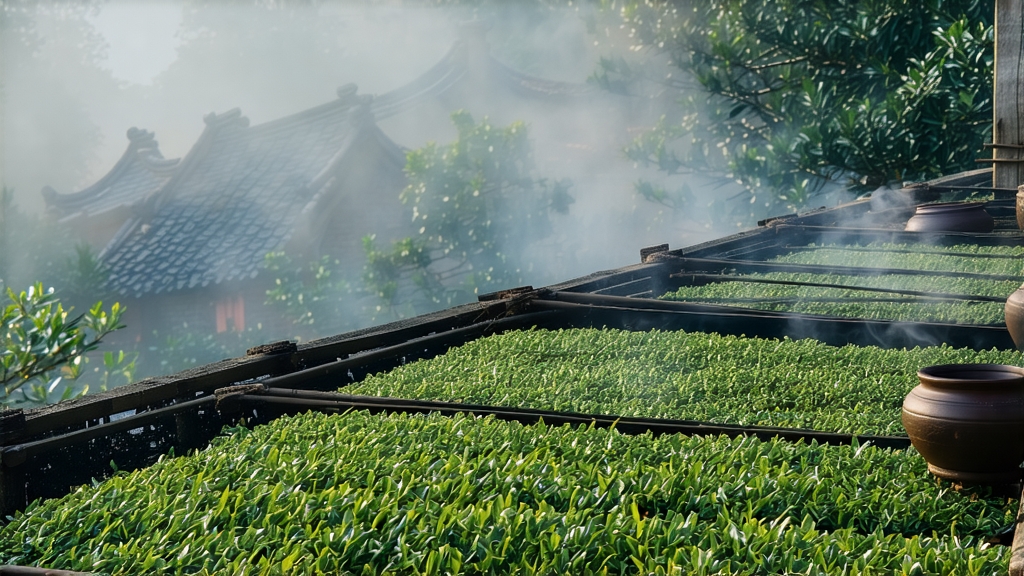
When European tea clippers first rounded the Cape of Good Hope in the late seventeenth century, the chests that fetched the highest prices at London and Amsterdam auctions bore a strange Chinese name—Lapsang Souchong. Merchants spoke of a black leaf that carried the scent of a winter hearth, a flavor so novel it re-defined what “tea” could taste like. Today, connoisseurs still argue whether the original smoked tea was an accident of war-time haste or a deliberate stroke of Wuyi Mountain genius, yet all agree that Lapsang Souchong is the primogenitor of every black tea on earth.
Geographic Birthplace
The micro-valley of Tongmu Guan, tucked inside Fujian Province’s Wuyi UNESCO World Heritage site, is less than 300 hectares of workable land. Here, a subtropical monsoon collides with mineral-rich granite soils, creating 80 % humidity and a perpetual fog that slows leaf growth, concentrating sugars, amino acids and aromatic oils. Only leaves picked within this 27th parallel enclave may legally bear the name “Zheng Shan” (original mountain) Xiao Zhong, the Chinese term for authentic Lapsang Souchong.
Two Families, Same Root
Farmers divide the tea into two stylistic branches. The traditional smoked version, still produced for Russia and the Middle East, is withered over open pine fires, rolled, oxidized, then hot-smoked a second time in bamboo baskets suspended over resinous Masson pine embers. The newer “unsmoked” or “craft” style, developed for Western specialty markets, omits the final smoking, allowing the natural honey, longan-fruit and mineral notes to dominate. Both styles share the same cultivar—Xiao Ye Zhong (Small Leaf Variety)—an indigenous shrub with narrow, wax-coated leaves that tolerate high heat without losing sweetness.
Crafting Smoke with Precision
Harvest begins the first clear morning after Qingming festival, when two leaves and a bud still hold overnight dew. The leaves are laid on bamboo mats above a ground-level firepit; pine logs burned to embers release a steady 28 °C updraft that withers rather than bakes. After 8–10 hours the leaf is supple enough to roll; a 45-minute machine kneading ruptures 70 % of cell walls, launching enzymatic oxidation that turns the leaf copper within two hours. The crucial smoking follows: baskets stacked three tiers high are lidded with fir bark to trap smoke; every ten minutes the master smoker tosses the leaves, ensuring each strand absorbs phenols that will later read as cigar box, pine resin and winter spice. A final charcoal bake at 85 °C locks moisture below 6 %, allowing the tea to travel the world without losing its signature aroma.
Brewing the Campfire in a Cup
Western baristas often over-handle Lapsang, treating it like an English Breakfast. Instead, treat it like a peated whisky—respect the smoke. Use 3 g of leaf for 150 ml of water, 90 °C, in a tall thin glass or small zhong. The first infusion, 5 seconds only, is a rinse that awakens the pine oils; discard. The second, 12 seconds, delivers a clear amber liquor and a nose of burning cedar planks. Steepings three to five can be pushed to 30, 45, then 60 seconds; the smoke recedes, revealing molasses, dried longan and a wet-stone minerality that echoes the Wuyi cliffs. Smoked versions pair brilliantly with oily fish, dark chocolate or a post-prandial cigar; unsmoked versions marry with Comté cheese or apricot tart.
Tasting Ritual: From Embers to Echo
Professional cuppers use a “two-bowl” method: liquor is poured into a white porcelain cup for color, while the wet leaves are sniffed in a lidded aroma bowl. First, assess dryness—good smoke should feel cool, not acrid. Second, seek length—the finish should drift back as sweet pine, not ashtray. Finally, check for “Wuyi Yun,” the rocky rhyme, a tingling mineral echo on the sides of the tongue that proves mountain origin. Counterfeit teas from Vietnam or Kenya often smell smoky but lack this lingering stoniness.
Storage and Aging Potential
Because of its phenolic load, well-smoked Lapsang is among the few black teas that improve with age. Store in tin-lined canisters away from light and strong odors; at